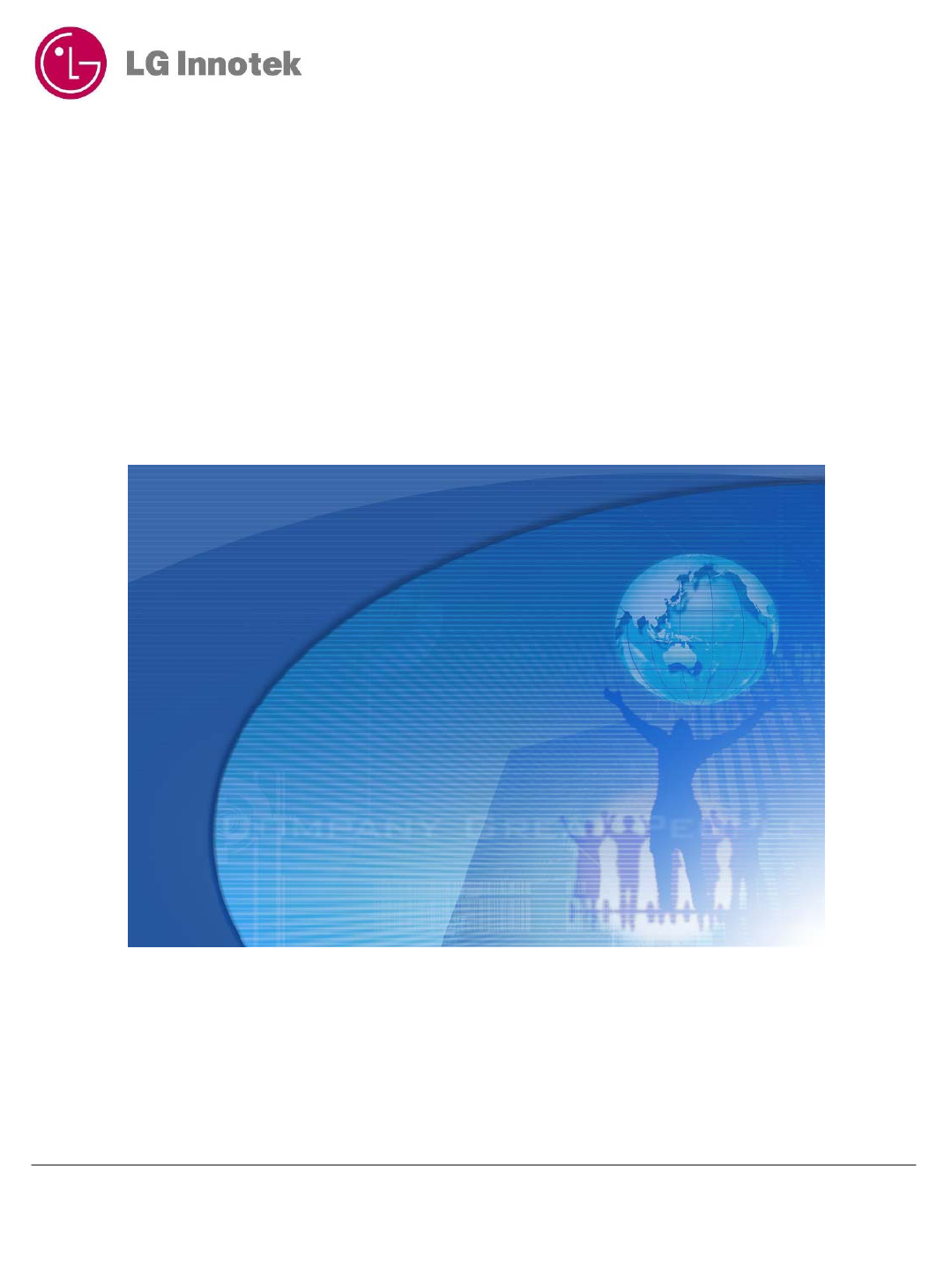LG Electronics USA RBFS-C921A Bluetooth Module User Manual
LG Electronics USA Bluetooth Module Users Manual
Users Manual

Description of Functional Blocks
Description of Functional Blocks
RBFS
RBFS-
-C921A BT Ass
C921A BT Ass’
’y Module
y Module
Rev A,
Rev A, Feb
Feb 2009
2009
LG Innotek
Hanyang Univ. 1271, Sa-dong, Sangrok-gu ,
Ansan-si, Gyeonggi-do 426-791, Korea
Tel:82-31-436-7653
Fax:82-31-436-7991
www.lginnotek.com
COMMERCIAL IN CONFIDENCE
Copyright ⓒ2007, LG Innotek Co., Ltd. http:\\www.lginnotek.com
All specification are preliminary and LG Innotek reserves the right to change these without notice.
RBFS-C921A-AN-01-A

Page 1
RBFS-C921A-AN-01-A
R
RBFS
BFS-
-C921A
C921A
1. RF Receiver Block
1.1 RF Receiver
The receiver features a near-zero Intermediate Frequency (IF) architecture that allows
the channel filters to be integrated onto the die. Sufficient out-of-band blocking
specification at the Low Noise Amplifier (LNA) input allows the radio to be used in
close proximity to Global System for Mobile Communications (GSM) and Wideband
Code Division Multiple Access (W-CDMA) cellular phone transmitters without being
desensitised. The use of a digital Frequency Shift Keying (FSK) discriminator means
that no discriminator tank is needed and its excellent performance in the presence of
noise allows BlueCore4-ROM WLCSP to exceed the Bluetooth requirements for co-
channel and adjacent channel rejection. For EDR, an ADC is used to digitise the IF
received signal.
1.1.1 Low Noise Amplifier
The LNA can be configured to operate in single-ended or differential mode. Single-
ended mode is used for Class 1 Bluetooth operation; differential mode is used for
Class 2 operation.
1.1.2 Analogue to Digital Converter
The Analogue to Digital Converter (ADC) is used to implement fast Automatic Gain
Control (AGC). The ADC samples the Received Signal Strength Indicator (RSSI)
voltage on a slot-by-slot basis. The front-end LNA gain is changed according to the
measured RSSI value, keeping the first mixer input signal within a limited range. This
improves the dynamic range of the receiver, improving performance in interference
limited environments.

Page 2
RBFS-C921A-AN-01-A
R
RBFS
BFS-
-C921A
C921A
2. RF Transmitter Block
2.1 IQ Modulator
The transmitter features a direct IQ modulator to minimise the frequency drift during a
transmit timeslot, which results in a controlled modulation index. Digital baseband
transmit circuitry provides the required spectral shaping.
2.2 Power Amplifier
The internal Power Amplifier (PA) has a maximum output power of +6dBm. This
allows Bluetooth Main Chipset to be used in Class 2 and Class 3 radios without an
external RF PA. Support for transmit power control allows a simple implementation for
Class 1 with an external RF PA. But Our Module support Class2 type
2.3 Auxiliary DAC
An 8-bit voltage Auxiliary DAC is provided for power control of an external PA for
Class 1 operation or any other customer specific application.

Page 3
RBFS-C921A-AN-01-A
R
RBFS
BFS-
-C921A
C921A
3. RF Synthesiser
The radio synthesiser is fully integrated onto the die with no requirement for an external
Voltage Controlled Oscillator (VCO) screening can, varactor tuning diodes, LC resonators or
loop filter. The synthesiser is guaranteed to lock in sufficient time across the guaranteed
temperature range to meet the Bluetooth v2.0 + EDR specification.
4. Power Control and Regulation
Bluetooth Module contains two linear regulators. The high-voltage regulator generates a 1.8V
output which is used to power the IO circuits. A low drop out low-voltage regulator is used to
generate the 1.5V core supply from the 1.8V IO supply.
5. Clock Input and Generation
The reference clock for the system is generated from a TCXO or crystal input between 8MHz
and 40MHz. All internal reference clocks are generated using a phase locked loop, which is
locked to the external reference frequency. Bluetooth Module(U1) included crystal unit.

Page 4
RBFS-C921A-AN-01-A
R
RBFS
BFS-
-C921A
C921A
6. USB
This is a full speed Universal Serial Bus (USB) interface for communicating with other
compatible digital devices. Bluetooth Module(U1) acts as a USB peripheral, responding
to requests from a master host controller such as a PC.
7. 802.11 Co-Existence Interface
Dedicated hardware is provided to implement a variety of 802.11 (Wi-Fi) co-existence
schemes. Channel skipping AFH, priority signalling, channel signalling and host passing of
channel instructions are all supported. The features are configured in firmware. The details
of some methods are proprietary (e.g., Intel WCS). Contact CSR for details.

Page 5
RBFS-C921A-AN-01-A
R
RBFS
BFS-
-C921A
C921A
8. Memory Interface
The SDRAM is a quad-bank DRAM that operates at 1.8V or 2.5V and includes a
synchronous interface (all signals are registered on the positive edge of the clock signal,
CLK ). Read and write accesses accesses to the SDRAM are burst oriented; accesses start
at a selected location and continue for a programmed number of locations in a programmed
sequence.
The Nor Flash devices are 512K x16 CMOS Multi-Purpose Flash (MPF) manufactured with
high performance CMOS SuperFlash technology. The split-gate cell design and thick oxide
tunneling injector attain better reliability and manufacturability compared with alternate
approaches. The Flash write (Program or Erase) with a 3.0-3.6V power supply. The Flash
write (Program or Erase) with a 2.7-3.6V power supply. These devices conform to JEDEC
standard pinouts for x16 memories.
9. RISC DSP Processor
This is designed as a System On a Chip : system controller and decoder controller for
multi‐format digital audio player with access of various storage such as USB, SD/MMC
card, NOR flash and etc. The independent dual 32‐bit RISC processors provide optimum
performance and code density for the combination of control code and signal processing
required for digital audio decoding, file system management and system control.
The integrates programmable and approved ARM7TDMI™ as a system controller for
advanced multi‐format digital audio (MP3/WMA/Ogg) decoding, low power dedicated
hardwired CDROM decoder, On‐chip SRAM and ROM, versatile audio interfaces of USB
1.1 host/device, SD/MMC card, and large number of GPIO (General Purpose Input Output)
ports. In addition, SRS (WOW), MP3 encoding and WMA encoding features are available
as system solutions. By utilizing advanced 0.13 micron technology.

Page 6
RBFS-C921A-AN-01-A
R
RBFS
BFS-
-C921A
C921A
RECORD OF CHANGES
Revision No. Date Description
AFeb. 2009 Initial Release

Page 7
RBFS-C921A-AN-01-A
R
RBFS
BFS-
-C921A
C921A
Contact for Support
Name : inpyo Park
E-mail : ippark@lginnotek.com
Tel : 82-31-436-7653
Fax : 82-31-436-7991

RBFS-C921A-AN-01-A Page 8
■ RRBFSBFS-C921A
FCC compliance Information
This device complies with part 15 of FCC Rules. Operation is subject to the following two conditions:
1. This device may not cause harmful interference received.
2. This device must accept any interference received. Including interference that may cause undesired operation.
FCC WARNING
This equipment may generate or use radio frequency energy. Changes or modifications to this equipment may
cause harmful interference unless the modifications are expressly approved in the instruction manual. The user
could lose the authority to operate this equipment if an unauthorized change or modification is made.
To satisfy FCC exterior labeling requirements, the following text must be placed on the exterior Of the end
product.
Contains Transmitter Module FCC ID: BEJRBFS-C921A
CAUTION: This device and it’s antenna(s) must not be co-located or operated in conjunction with any other
antenna or transmitter. End users cannot modify this transmitter device. Any Unauthorized modification could void
the user’s authority to operate this device.